9-demicube
| Demienneract (9-demicube) | ||
|---|---|---|
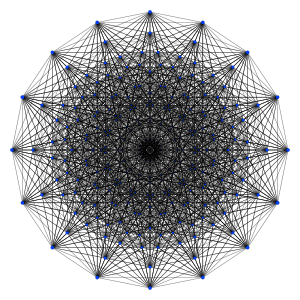 Petrie polygon | ||
| Type | Uniform 9-polytope | |
| Family | demihypercube | |
| Coxeter symbol | 161 | |
| Schläfli symbol | {3,36,1} = h{4,37} s{21,1,1,1,1,1,1,1} | |
| Coxeter-Dynkin diagram | ||
| 8-faces | 274 | 18 {31,5,1} 256 {37} |
| 7-faces | 2448 | 144 {31,4,1} 2304 {36} |
| 6-faces | 9888 | 672 {31,3,1} 9216 {35} |
| 5-faces | 23520 | 2016 {31,2,1} 21504 {34} |
| 4-faces | 36288 | 4032 {31,1,1} 32256 {33} |
| Cells | 37632 | 5376 {31,0,1} 32256 {3,3} |
| Faces | 21504 | {3} |
| Edges | 4608 | |
| Vertices | 256 | |
| Vertex figure | Rectified 8-simplex | |
| Symmetry group | D9, [36,1,1] = [1+,4,37] [28]+ | |
| Dual | ? | |
| Properties | convex | |
In geometry, a demienneract or 9-demicube is a uniform 9-polytope, constructed from the 9-cube, with alternated vertices truncated. It is part of a dimensionally infinite family of uniform polytopes called demihypercubes.
Coxeter named this polytope as 161 from its Coxeter diagram, with a ring on
one of the 1-length branches, ![]()
![]()
![]()
![]()
![]()
![]()
![]()
![]()
![]()
![]()
![]()
![]()
![]()
![]()
![]() .
.
Cartesian coordinates
Cartesian coordinates for the vertices of a demienneract centered at the origin are alternate halves of the enneract:
- (±1,±1,±1,±1,±1,±1,±1,±1,±1)
with an odd number of plus signs.
Images
| Coxeter plane | B9 | D9 | D8 |
|---|---|---|---|
| Graph | 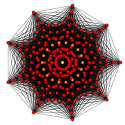 |
 |
 |
| Dihedral symmetry | [18]+ = [9] | [16] | [14] |
| Graph | 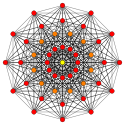 |
 | |
| Coxeter plane | D7 | D6 | |
| Dihedral symmetry | [12] | [10] | |
| Coxeter group | D5 | D4 | D3 |
| Graph |  |
 |
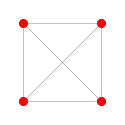 |
| Dihedral symmetry | [8] | [6] | [4] |
| Coxeter plane | A7 | A5 | A3 |
| Graph |  |
 |
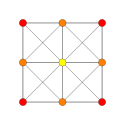 |
| Dihedral symmetry | [8] | [6] | [4] |
References
- H.S.M. Coxeter:
- Coxeter, Regular Polytopes, (3rd edition, 1973), Dover edition, ISBN 0-486-61480-8, p.296, Table I (iii): Regular Polytopes, three regular polytopes in n-dimensions (n≥5)
- H.S.M. Coxeter, Regular Polytopes, 3rd Edition, Dover New York, 1973, p.296, Table I (iii): Regular Polytopes, three regular polytopes in n-dimensions (n≥5)
- Kaleidoscopes: Selected Writings of H.S.M. Coxeter, edited by F. Arthur Sherk, Peter McMullen, Anthony C. Thompson, Asia Ivic Weiss, Wiley-Interscience Publication, 1995, ISBN 978-0-471-01003-6
- (Paper 22) H.S.M. Coxeter, Regular and Semi Regular Polytopes I, [Math. Zeit. 46 (1940) 380-407, MR 2,10]
- (Paper 23) H.S.M. Coxeter, Regular and Semi-Regular Polytopes II, [Math. Zeit. 188 (1985) 559-591]
- (Paper 24) H.S.M. Coxeter, Regular and Semi-Regular Polytopes III, [Math. Zeit. 200 (1988) 3-45]
- John H. Conway, Heidi Burgiel, Chaim Goodman-Strass, The Symmetries of Things 2008, ISBN 978-1-56881-220-5 (Chapter 26. pp. 409: Hemicubes: 1n1)
- Richard Klitzing, 9D uniform polytopes (polyyotta), x3o3o *b3o3o3o3o3o3o - henne
External links
- Olshevsky, George, Demienneract at Glossary for Hyperspace.
- Multi-dimensional Glossary
| Fundamental convex regular and uniform polytopes in dimensions 2–10 | ||||||||||||
|---|---|---|---|---|---|---|---|---|---|---|---|---|
| Family | An | Bn | I2(p) / Dn | E6 / E7 / E8 / F4 / G2 | Hn | |||||||
| Regular polygon | Triangle | Square | p-gon | Hexagon | Pentagon | |||||||
| Uniform polyhedron | Tetrahedron | Octahedron • Cube | Demicube | Dodecahedron • Icosahedron | ||||||||
| Uniform 4-polytope | 5-cell | 16-cell • Tesseract | Demitesseract | 24-cell | 120-cell • 600-cell | |||||||
| Uniform 5-polytope | 5-simplex | 5-orthoplex • 5-cube | 5-demicube | |||||||||
| Uniform 6-polytope | 6-simplex | 6-orthoplex • 6-cube | 6-demicube | 122 • 221 | ||||||||
| Uniform 7-polytope | 7-simplex | 7-orthoplex • 7-cube | 7-demicube | 132 • 231 • 321 | ||||||||
| Uniform 8-polytope | 8-simplex | 8-orthoplex • 8-cube | 8-demicube | 142 • 241 • 421 | ||||||||
| Uniform 9-polytope | 9-simplex | 9-orthoplex • 9-cube | 9-demicube | |||||||||
| Uniform 10-polytope | 10-simplex | 10-orthoplex • 10-cube | 10-demicube | |||||||||
| Uniform n-polytope | n-simplex | n-orthoplex • n-cube | n-demicube | 1k2 • 2k1 • k21 | n-pentagonal polytope | |||||||
| Topics: Polytope families • Regular polytope • List of regular polytopes | ||||||||||||